Inside the City of Gold’s abandoned vaults
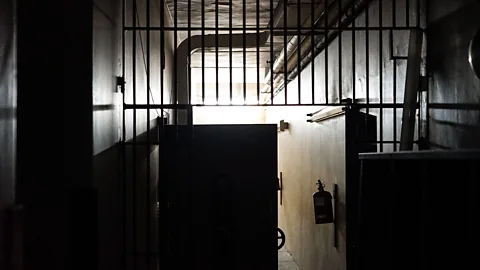 Alex Rawlings
Alex RawlingsMuch of Johannesburg’s financial district was abandoned for decades - and it provides some fascinating insights into South Africa's troubled history.
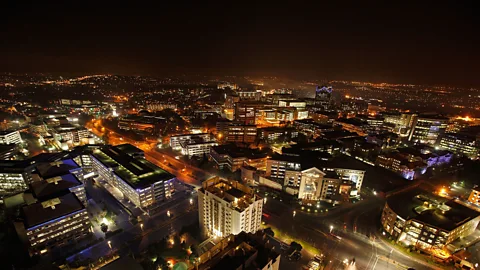 Getty
GettyJohannesburg is nicknamed the City of Gold. It was once one of the richest cities on the planet, producing around 80% of all the world’s gold. Yet after several decades of crime and decline, nowadays Joburg’s reputation precedes it as one of the most dangerous cities in the world.
Nowhere tells the story of Johannesburg’s rapid rise, decline and regeneration better than the Central Business District. To understand this city’s past, its present, and what might lie ahead, BBC Future took a tour of Johannesburg’s old financial district with Charlie Moyo and Gerald Garner of Joburg Places, discovering abandoned bank vaults, a disused Stock Exchange, and the exciting bars, restaurants and shops of the new South Africa springing up in the spaces that the old regime left behind.
(Image credit: Getty)
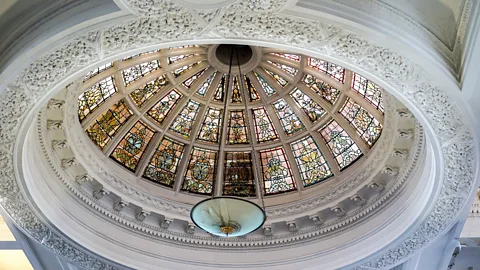 Alex Rawlings
Alex RawlingsJohannesburg sprung up in the middle of what was then called the Transvaal Republic after gold was discovered by an Englishman in 1886. At the time, the Transvaal was a largely Dutch-speaking rural country, established by Boer farmers fleeing British rule in the Cape.
The discovery of gold prompted one of the largest immigration waves the world has ever seen. The great gold rush brought thousands of people to settle on the plains of the Highveld. The country’s vast economic growth brought tension, however, as the immigrants vastly outnumbered the Boer citizens of the republic, bringing plenty of social tensions with them. These tensions would in part lead to a long and bloody war with the British Empire, known as the Anglo-Boer war, which ended with British victory in 1902.
The city’s riches from this period can be seen here in grand glass domed ceiling of the former Volkskas Bank (now ABSA) from 1904. Its grandeur is only enjoyed by visitors on historical tours, as the bank lies empty and in disuse.
(Image credit: Alex Rawlings)
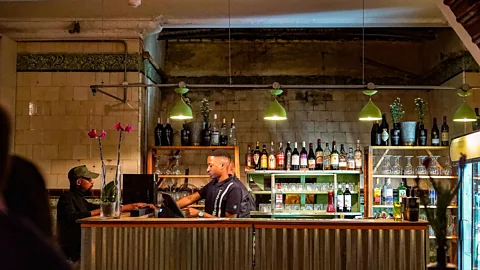 Alex Rawlings
Alex RawlingsAfter the British victory and the formation of the new Union of South Africa in 1910, life in Johannesburg went back to focusing on money. All over the city, banks and bank vaults sprung up, like this one where Johannesburg’s residents kept their wealth. This is the United Safety Deposits Vault, which was forced to close in 1976 after a bank heist made them go bankrupt. Now, it operates as Zwipi Underground Bar, offering private dining experiences in the old vaults. There are still 1,000 unopened safety deposit boxes in the basement. Nobody knows what might be inside.
(Image credit: Alex Rawlings)
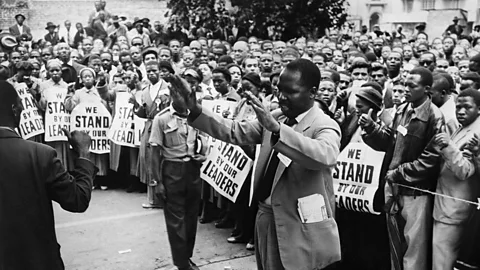 Getty
GettyVery few South Africans ever saw the wealth that came from Johannesburg’s gold rush, however. After the National Party crept into power with just 38% of the popular vote in the 1948 elections, they instituted a system of state-sponsored racial segregation, known as apartheid, which prevented businesses from employing more than six black South Africans, and kept non-white South Africans out of urban areas, denying them citizenship and even banishing them to so-called ‘homelands’.
For years, the world turned a blind eye to the racist policies of apartheid South Africa. It was only after pressure from Canada and India, following the Sharpeville massacre in 1960, that South Africa formally left the Commonwealth in 1961 and ceased to be a territory of the British crown. Our guides Charlie Moyo and Gerald Garner wryly refer to this moment as ‘Southexit’.
(Image credit: Getty)
 Alex Rawlings
Alex Rawlings‘Southexit’ only strengthened the country’s economy. South Africa’s newfound ‘independence’ enabled it to establish its own currency, the rand, which started trading at one rand to the US dollar. It would take many more years of campaigning by members of the liberation movement to draw the world’s attention to the horrors of apartheid, and to campaign for its figurehead Nelson Mandela’s release from prison on Robben Island.
In the 1980s, social unrest across the country plus international pressure forced South Africa to rethink apartheid. In 1985, President PW Botha announced that South Africa had “crossed the Rubicon”, was to end apartheid, and begin transitioning into a democratic state. At the last minute, however, he changed his mind. Apartheid was to continue. Almost overnight, the international community imposed harsh sanctions on South Africa, and many corporations deserted the country, leaving ritzy cosmopolitan inner-city areas such as Hillbrow vacant, and vulnerable to gangs who ‘hijacked’ the empty buildings and transformed them into the brothels and drug dens that give the area its notoriety today.
Here we see the eerie, dimly-lit passageways run along the abandoned bank vaults of Johannesburg.
(Image credit: Alex Rawlings)
 Alex Rawlings
Alex RawlingsIn the 1990s, under President FW de Klerk, South Africa began the process of dismantling apartheid and negotiating a settlement, including the release of Nelson Mandela and the planning of the country’s first inclusive democratic elections in 1994. However, the uncertainty of the 90s brought instability to Johannesburg. The scrapping of racial segregation laws heralded an enormous population boom, and the centre of Johannesburg also became a regular site for political demonstrations and unrest, as activists from opposing political parties clashed violently while their leaders continued to negotiate the peace settlement from behind closed doors.
So many of the social problems that apartheid had kept out of sight of most affluent white South Africans suddenly arrived in the centre of Johannesburg. Businesses and banks headed north to the emerging suburb of Sandton. Some banks did not have time to fully clear out, leaving documents, floppy disks and files littering the endless maze of vaults that lie beneath the streets of the city.
(Image credit: Alex Rawlings)
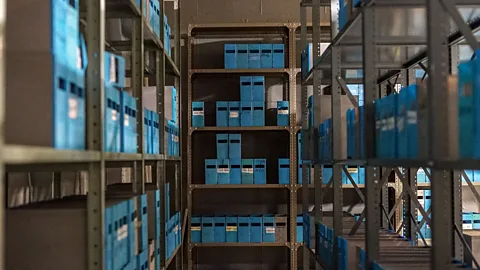 Alex Rawlings
Alex RawlingsRemnants of an analogue era – empty blue files that once contained details of all correspondence and all transactions of ABSA Bank’s customers still line the abandoned vaults.
(Image credit: Alex Rawlings)
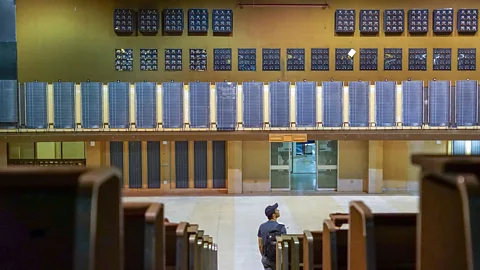 Alex Rawlings
Alex RawlingsThe home of the Johannesburg Stock Exchange, an imposing glass building at 17 Diagonal Street, was also a casualty of the move to the suburbs. Originally, this was designed to be the home of the JSE for 75 years. Eventually, it closed after just over 20, following the rest of the financial district to Sandton. The space has remained disused and abandoned since, occasionally serving as a function space for private parties.
Today, the old trading floor of the Johannesburg Stock Exchange lies unsettlingly still. The old rotary dial phones ring no more. The new Stock Exchange is now in Sandton, in the northern suburbs.
(Image credit: Alex Rawlings)
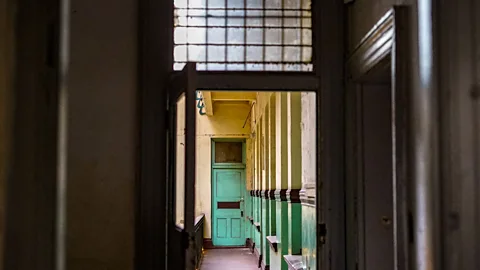 Ale Rawlings
Ale RawlingsThis is Somerset House (now the Thunderwalker), one of Joburg's greatest Art Deco treasures. Its original features survived years of disuse and squatters. Now it is being developed into apartments.
(Image credit: Alex Rawlings)
 Alex Rawlings
Alex RawlingsThe last decade has seen a remarkable transformation of inner-city Johannesburg. An emerging and increasingly affluent black middle class working in the CBD has increased demand for comfortable rental accommodation in the city, no longer content with long and exhausting commutes from townships such as Soweto where under Apartheid black South Africans were forced to live. This has encouraged new shops and businesses to open too, to serve them. The tourist industry was quick to follow, with hotels, hostels, brunch spots and bars springing up and transforming formerly slums such as Maboneng into the city’s bright and colourful hipster hangouts.
The former Johannesburg Stock Exchange was housed in an imposing Brutalist structure (seen here). Nowadays the almost completely disused building occasionally holds art exhibitions, but is looking for an investor with a vision for how to repurpose the space.
Despite its notoriety for violent crime, in 2018 Johannesburg was the most visited city in the whole of Africa, beating both the bazars of Marrakech and the sandy white beaches of its coastal rival Cape Town. As public transport infrastructure improves and ride-hailing apps change the way South Africans get around, there is now a fresh opportunity to bring people back into the inner-city of Johannesburg and transform it into a usable and cosmopolitan space for all South Africans.
(Image credit: Alex Rawlings)
